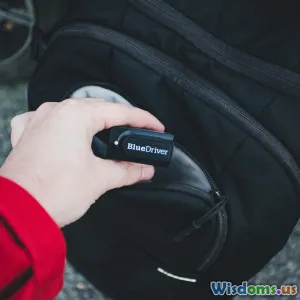
Reverse Engineering Smart Thermostats for Security Flaws
10 min read Explore the hidden security risks in smart thermostats through reverse engineering and learn how to safeguard your home from cyber threats. (0 Reviews)
Reverse Engineering Smart Thermostats for Security Flaws
Introduction
In an era where Internet of Things (IoT) devices have seamlessly woven into our daily lives, smart thermostats stand out as both a technological convenience and a security conundrum. The ability to fine-tune your home’s climate remotely can significantly enhance comfort and energy efficiency. Yet, beneath the surface, these devices potentially open backdoors for cyber-attacks — a fact often overlooked by manufacturers and users alike.
Reverse engineering smart thermostats provides not just a path to understanding their inner workings but also unravels critical security flaws that can compromise personal privacy and home safety. This article embarks on a comprehensive journey to dissect smart thermostats through reverse engineering, spotlighting vulnerabilities, their real-world implications, and strategies to mitigate these threats.
Understanding Smart Thermostats and Their Architecture
Before probing security flaws, it’s essential to understand what smart thermostats are and how they function within the ecosystem of smart homes.
What Is a Smart Thermostat?
Smart thermostats are IoT-enabled devices designed to regulate household temperature intelligently. Unlike traditional thermostats, they adjust heating and cooling based on user behavior, data analytics, and sometimes external factors like weather forecasts.
Popular examples include Google's Nest, Ecobee, and Honeywell's Lyric series. These devices connect to your Wi-Fi network, interface with mobile apps, and integrate with voice assistants.
Core Components and Communication Protocols
Typical smart thermostat architecture includes:
- Embedded Microcontrollers: These drive the device logic.
- Sensors: Temperature, humidity, and motion detectors.
- Connectivity Modules: Wi-Fi, Zigbee, or Z-Wave for communication.
- Software/Firmware: Coordinating system behavior, remote access, and data should be secure.
Communication predominantly relies on encrypted Wi-Fi connections; however, some older or budget models may employ less secure protocols.
Understanding these components lays the foundation to appreciate the vulnerabilities uncovered during reverse engineering.
Reverse Engineering Process: Techniques and Tools
Why Reverse Engineer Smart Thermostats?
Reverse engineering serves a dual purpose: to analyze protocol implementations for interoperability and, importantly, to identify and patch security vulnerabilities.
Tools and Techniques Used
-
Firmware Extraction and Analysis:
- Firmware images can be extracted via UART, JTAG interfaces, or directly from downloaded update files.
- Tools like Binwalk and IDA Pro help analyze and dissect code to find hidden vulnerabilities such as hardcoded credentials or insecure cryptographic functions.
-
Network Traffic Monitoring:
- Using Wireshark or tcpdump to capture and analyze packets exchanged between the thermostat and cloud services highlights potential weaknesses in communication.
-
Hardware Analysis:
- Physical inspection of the circuit board allows identification of debugging ports and chips for in-depth physical attacks.
-
Software Debugging:
- Emulating firmware or running it in a controlled environment using QEMU enables dynamic analysis of execution.
Case Study: Reverse Engineering the Nest Thermostat
In 2016, security researchers demonstrated that by exploiting a firmware vulnerability in the Nest Thermostat, attackers gained root access, allowing them to control temperature settings and potentially expand their foothold into home networks.
The breach highlighted loopholes in firmware update verification and insufficient isolation between software components.
Identified Security Flaws in Smart Thermostats
Insecure Communication Channels
Despite improvements, several devices transmit data in unencrypted form or use weak encryption schemes.
Example: A 2019 study reported that some smart thermostats still used outdated TLS protocols susceptible to man-in-the-middle (MITM) attacks, which could expose user credentials.
Hardcoded Credentials and Keys
Firmware often contains hardcoded passwords or cryptographic keys, which, once extracted via reverse engineering, enable attackers to impersonate devices or intercept communications.
Firmware Update Vulnerabilities
Sophisticated attacks exploit poorly secured update processes. Without proper code signing and integrity checks, malicious firmware can be injected remotely.
Insufficient Network Segmentation
Smart thermostats connected to the primary home network without segmentation provide potential attackers a pivot point to other critical devices.
Physical Access Risks
Devices located in accessible areas can be tampered with directly to extract sensitive data or escalate privileges.
Real-World Impact of Thermostat Security Flaws
Privacy Compromise
Personal routines and occupancy data inferred from thermostat usage can be harvested for stalking or burglary planning.
Energy Theft and Cost Manipulation
Attackers gaining control might cause anomalous energy use, leading to inflated utility bills or energy wastage.
Home Network Breaches
Compromised thermostats might act as entry points for attackers to infiltrate more sensitive devices like security cameras or personal computers.
Example: The Mirai Botnet Scenario
While not specific to thermostats, the Mirai botnet attack in 2016 showcased how unsecured IoT devices could contribute to massive DDoS attacks, raising concerns about smart home device security at large.
Best Practices to Enhance Security in Smart Thermostats
1. Firmware Hardening and Regular Updates
Manufacturers must implement code signing and secure OTA (Over-The-Air) updates. Users should ensure their devices run the latest firmware versions.
2. Secure Communication
All data exchanged by smart thermostats must deploy current encryption standards like TLS 1.3, with certificate pinning to prevent MITM attacks.
3. Eliminate Hardcoded Secrets
Use dynamic key management approaches; avoid embedding static credentials inside firmware.
4. Network Segmentation
Place smart devices on separate VLANs or guest networks with strict firewall rules to reduce exposure.
5. Physical Security Measures
Install devices in locations that limit physical access or tampering.
User Awareness
Consumers should understand the security risks and opt for devices from companies with transparent security policies and ongoing support.
The Ethical Side and Legal Implications of Reverse Engineering
While reverse engineering can reveal security weaknesses, it raises legal and ethical questions, especially regarding intellectual property rights and user privacy.
Security researchers must adhere to responsible disclosure policies, reporting findings to vendors and coordinating fixes.
Conversely, users and developers benefit hugely from community-driven audits that push industry standards forward.
Conclusion
Smart thermostats encapsulate the marvelous intersection of comfort and technology—but also underscore the rising cybersecurity challenges in the expanding IoT landscape. Through reverse engineering, security researchers uncover vulnerabilities that, if left unaddressed, could imperil users’ privacy, finances, and digital safety.
The path to securing smart thermostats requires collaboration among manufacturers, security experts, and informed consumers embracing best practices.
By demystifying these devices’ underpinnings and the lurking threats, we empower readers not only to appreciate the technology’s sophistication but also to take proactive steps in safeguarding their connected homes.
As smart homes gain ubiquity, vigilance and innovation in security must evolve in tandem to ensure our dream of a convenient, connected life does not morph into a nightmare of vulnerabilities.
References
- Costin, A., Zaddach, J., Francillon, A., & Balzarotti, D. (2016). A Large-Scale Analysis of the Security of Embedded Firmwares. USENIX Security Symposium.
- Checkoway, S., et al. (2016). “Reverse Engineering and Security Issues of Smart Home Thermostats.” Journal of Cybersecurity.
- IoT Security: Guidelines for Internet-Connected Devices. NIST Special Publication.
- The Mirai Botnet: What Happened After the Attack. IEEE Spectrum.
Note: The provided examples and studies aim to depict realistic insights based on current smart thermostat security research and reverse engineering techniques.
Rate the Post
User Reviews
Popular Posts
















